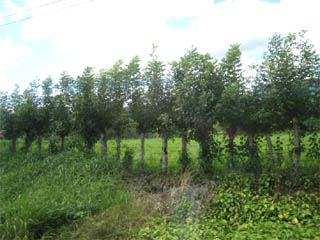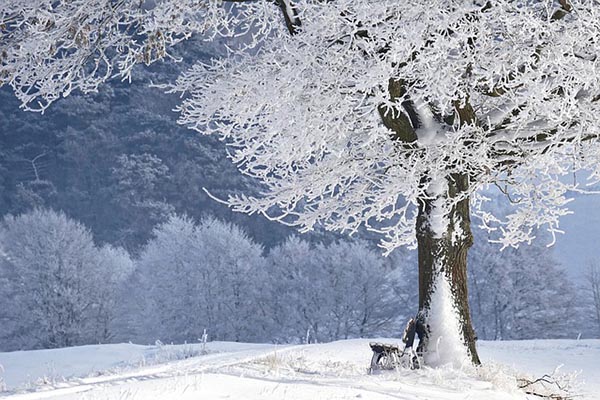Fence Posts, Beans and Fishing
 The problems in putting up acres of fence posts are that they are expensive; secondly they do not last-even treated ones. How would you like a free fence line that lasts over a hundred years? Grow your own fence posts. I am serious about this, as shown in the picture; the Catalpa tree row was five years old when the picture was taken. These are tough trees, they are not fussy about soil conditions, and are drought resistant. A neighbor has one that is over a hundred years old, still growing, still providing shade.
The problems in putting up acres of fence posts are that they are expensive; secondly they do not last-even treated ones. How would you like a free fence line that lasts over a hundred years? Grow your own fence posts. I am serious about this, as shown in the picture; the Catalpa tree row was five years old when the picture was taken. These are tough trees, they are not fussy about soil conditions, and are drought resistant. A neighbor has one that is over a hundred years old, still growing, still providing shade.
For years I have pondered, as many other Back2theLand people, about putting in an acreage fence for livestock, or just follow Proverbs to make for better neighbors.
I have considered making concrete posts-and those would be perfect-except I would need a tractor to lift the posts.
Metal posts have their application, but are expensive. Wood treated posts are good, but they will rot out too. Since wood posts are the prevalent post I have been studying on the topic and learned after twenty years of rot how to delay problems with treated posts for a longer period of time.
First of all what are you fencing in? Buffalo? Cattle? Goats? Sheep? Pigs? Chickens? Pheasants? Also what are you fencing out-Deer? Coyotes? Children? Birds?
Each fence type requires a different barrier attachment, and each attachment requires a different type of post. There are electrical barriers, barbed wire barriers, high tensile barriers, cattle, sheep, goat, and pig wire barriers as well as plastic fence barriers.
Of course all this is rural living with acreage separating you and the neighbors-or no neighbors, just a property line of old fence posts rotting away and disappearing in the weeds-then you have to resurvey to find out where your line is. Within this purview I have a three acre tract I will use Catalpa trees to provide a lifetime plus support for fencing, and another 200 yard fence line of Catalpa trees as a property line for an absent landlord fence. The secret to growing the Catalpa tree is right now-the beans have formed on the trees. Just before they split next month and drop the very tiny seed to the wind, I pick them, place them in a big paper bag, mark the bag, and place it in a dry area so they will continue to split and drop seed.
Later this winter in the greenhouse, heated, or unheated, I spread the beans on a growing flat filled ¾ way up with moist potting soil. There may be some loose seed in the bag and I dribble this out too. In the spring, keeping the soil reasonably moist there will appear the tiniest of tiny small seedlings. Leave them alone, and when they are a couple inches tall, transplant to cans.
Lightly fertilize through the spring and summer in the can with fish fertilizer base, or a mild fertilizer of your choice. Plan on many cans, as a few might not make it. You will, when the tiny trees reach a foot or more, plant them on a measured 10’ apart (for a fence line).
We plant in the fall time as it is wetter than the dry spring and summer which usually kills off all new planted trees because we do not lug 15 gallons of water a week to each tree to keep it alive. Besides, fall and winter is root growing time. After you have planted the small trees insert a Scott fruit tree spike close by. These seem to energize growth. In fact each year in the fall after the tree sheds it leaves in September, insert another fertilizer spike for increased growth at the leaf drip line.
To understand the fertilization factor, the trees in the above picture were planted for shade in the west side of our house. They are now above the second story windows. Unfertilized trees are about 8’ high and bushy. Trees need fertilizer and pruning.
As a property line boarder, keep in mind the branches will overhang the line. So plant a measured 6 feet inside the line and sink a pipe, or metal fence rod, along the sight line, later running a single wire on top for boundary accuracy.
Assuming you are going to use the trees to string fence wire, nail a treated board, oak or locust board to the tree in the vertical first. You attach the fence wire to the secure board and in that way you will not have the tree growing over the wire. Fence wire grown over with the tree will cause problems in later years if you want to remove the tree, otherwise with the board method you just pull the fence wire and board off the tree.
You will need to prune the first 6’, or so, of the tree trunk from branches, as this tree tends to fork. After the cut, spray the cut limb with automotive undercoating to keep the viruses out. I no longer cut close to the main trunk; I leave a 2” stub protruding out as nature does in breaking limbs, and I find less problems with bark not growing over the stub as it dries out.
Leaves come out in May and fall in September, which makes for a proper shade tree. The leaves make good compost, as does the worm poop falling from the fish bait green and black striped Catalpa caterpillar worms, which enjoy a symbiosis with the tree. In Alabama for example, the thousands of trees are planted for fish bait worms. Do not place your doghouse, pet food, or water dishes under these trees however; the worm poop is toxic to mammals. Slippery too.
If you are going to use treated posts, use the ones from a farm store that look real dark orange/green. They are heavy-duty pressure treated. When home, put on your eye protection goggles and gloves to paint the lower two feet six inches of post with Copper Brown, or Copper Green wood treatment-use several coats. When dry coat it with black tar roof coating, preferably use two coats. Dry. Now set the poles in the ground 2 feet deep leaving a few tarred inches above for reducing bacteria/fungus rot. Some experts on fences recommend a three-foot deep hole, partially filled with gravel to keep the pole end dry.
Lastly, Catalpa trees make very excellent firewood, and as a fast grower to your future wood lot they could become very valuable to you.
E-mail me at: back2theland@swva.net
COPYRIGHT: 2008, Back2theLand, Mark Steel



